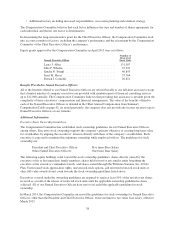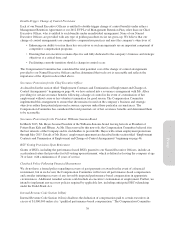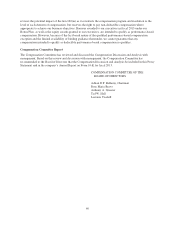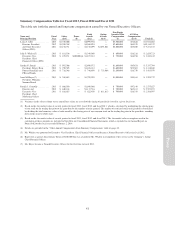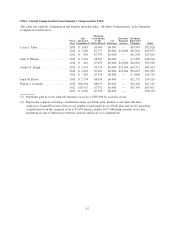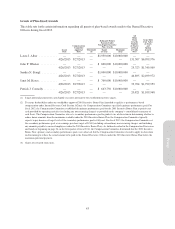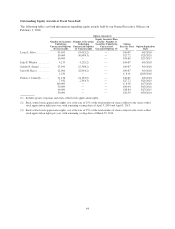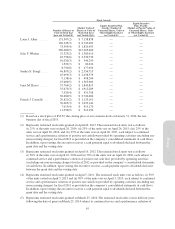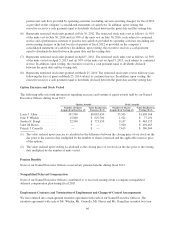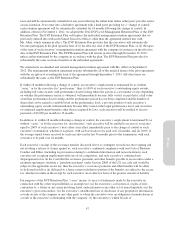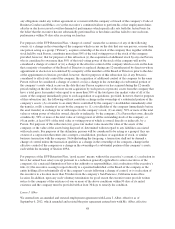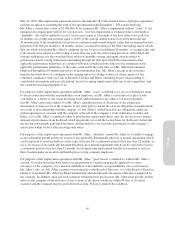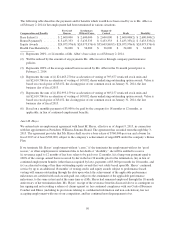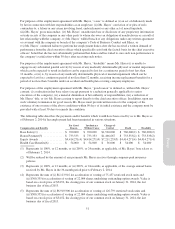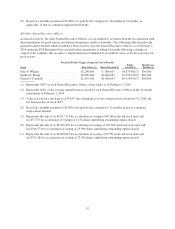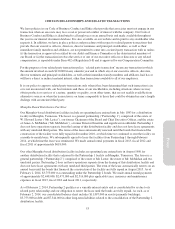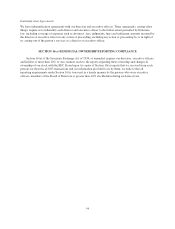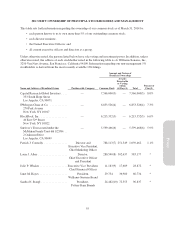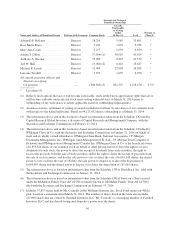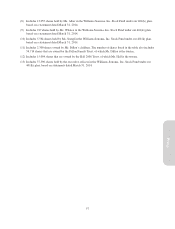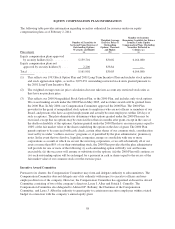Pottery Barn 2013 Annual Report Download - page 140
Download and view the complete annual report
Please find page 140 of the 2013 Pottery Barn annual report below. You can navigate through the pages in the report by either clicking on the pages listed below, or by using the keyword search tool below to find specific information within the annual report.any obligations under any written agreement or covenant with the company or breach of the company’s Code of
Business Conduct and Ethics; or (vi) the executive’s continued failure to perform his or her employment duties
after he or she has received a written demand of performance which specifically sets forth the factual basis for
the belief that the executive has not substantially performed his or her duties and has failed to cure such non-
performance within 30 days after receiving such notice.
For purposes of the EVP Retention Plan, “change of control” means the occurrence of any of the following
events: (i) a change in the ownership of the company which occurs on the date that any one person, or more than
one person acting as a group (“Person”), acquires ownership of the stock of the company that, together with the
stock held by such Person, constitutes more than 50% of the total voting power of the stock of the company;
provided, however, that for purposes of this subsection (i), the acquisition of additional stock by any one Person,
who is considered to own more than 50% of the total voting power of the stock of the company will not be
considered a change of control; or (ii) a change in the effective control of the company which occurs on the date
that a majority of members of the Board of Directors is replaced during any 12-month period by directors whose
appointment or election is not endorsed by a majority of the members of the Board of Directors prior to the date
of the appointment or election; provided, however, that for purposes of this subsection (ii), if any Person is
considered to effectively control the company, the acquisition of additional control of the company by the same
Person will not be considered a change of control; or (iii) a change in the ownership of a substantial portion of
the company’s assets which occurs on the date that any Person acquires (or has acquired during the 12-month
period ending on the date of the most recent acquisition by such person or persons) assets from the company that
have a total gross fair market value equal to or more than 50% of the total gross fair market value of all of the
assets of the company immediately prior to such acquisition or acquisitions; provided, however, that for purposes
of this subsection (iii), the following will not constitute a change in the ownership of a substantial portion of the
company’s assets: (A) a transfer to an entity that is controlled by the company’s stockholders immediately after
the transfer, or (B) a transfer of assets by the company to: (1) a stockholder of the company (immediately before
the asset transfer) in exchange for or with respect to the company’s stock, (2) an entity, 50% or more of the total
value or voting power of which is owned, directly or indirectly, by the company, (3) a Person that owns, directly
or indirectly, 50% or more of the total value or voting power of all the outstanding stock of the company, or
(4) an entity, at least 50% of the total value or voting power of which is owned, directly or indirectly, by a
Person. For purposes of this subsection (iii), gross fair market value means the value of the assets of the
company, or the value of the assets being disposed of, determined without regard to any liabilities associated
with such assets. For purposes of this definition, persons will be considered to be acting as a group if they are
owners of a corporation that enters into a merger, consolidation, purchase or acquisition of stock, or similar
business transaction with the company. Notwithstanding the foregoing, a transaction shall not be deemed a
change of control unless the transaction qualifies as a change in the ownership of the company, change in the
effective control of the company or a change in the ownership of a substantial portion of the company’s assets,
each within the meaning of Section 409A.
For purposes of the EVP Retention Plan, “good reason” means, without the executive’s consent, (i) a reduction in
his or her annual base salary (except pursuant to a reduction generally applicable to senior executives of the
company), (ii) a material diminution of his or her authority or responsibilities, (iii) a reduction of the executive’s
title, (iv) the executive ceasing to report directly to a specified individual or the Board of the company or the
entity holding all or substantially all of the company’s assets following a change of control, or (v) relocation of
the executive to a location more than 50 miles from the company’s San Francisco, California main office
location. In addition, upon any such voluntary termination for good reason the executive must provide written
notice to the company of the existence of one or more of the above conditions within 90 days of its initial
existence and the company must be provided with at least 30 days to remedy the condition.
Laura J. Alber
We entered into an amended and restated employment agreement with Laura J. Alber, effective as of
September 6, 2012, which amended and restated the prior agreement entered into with Ms. Alber, effective
48


